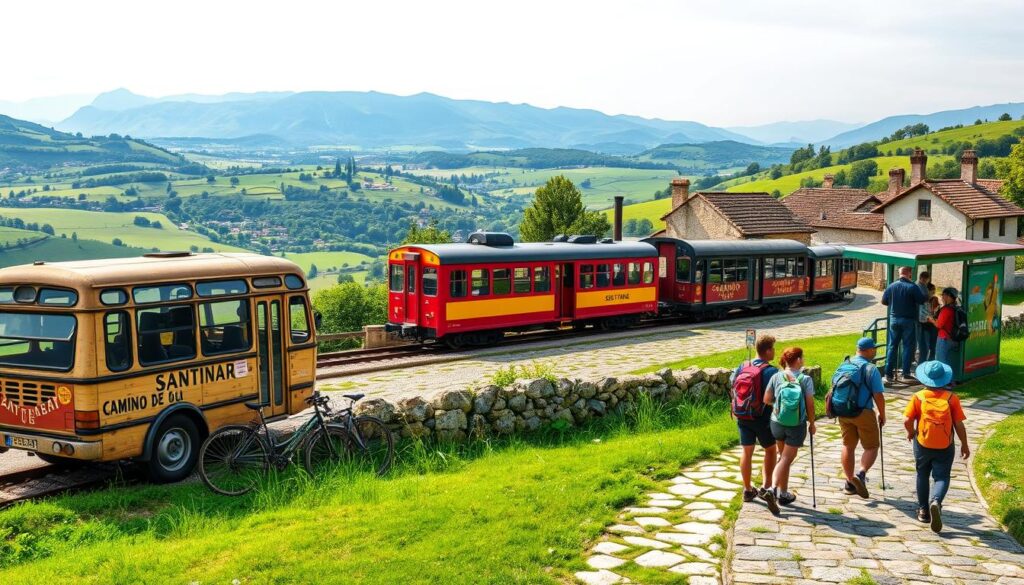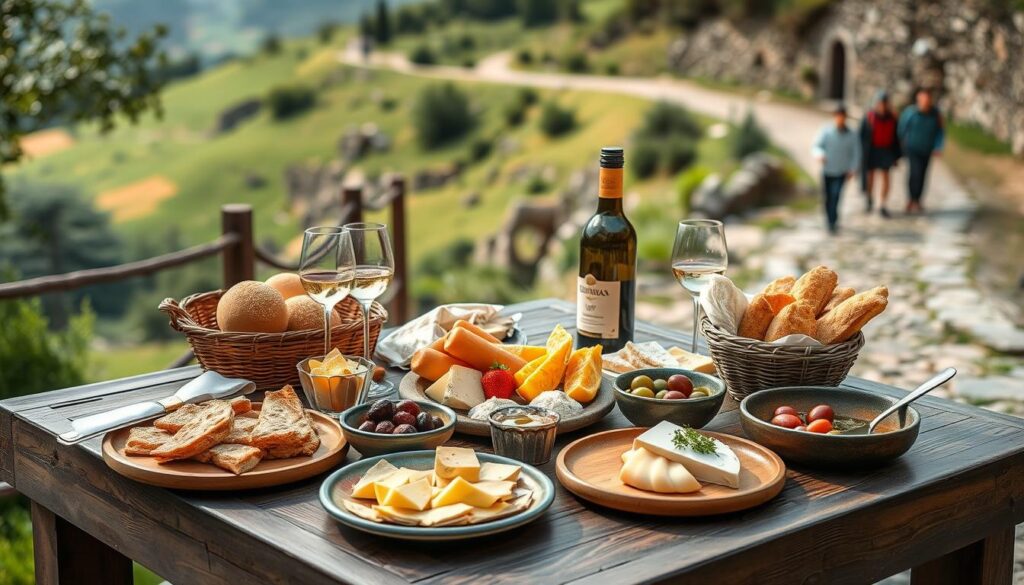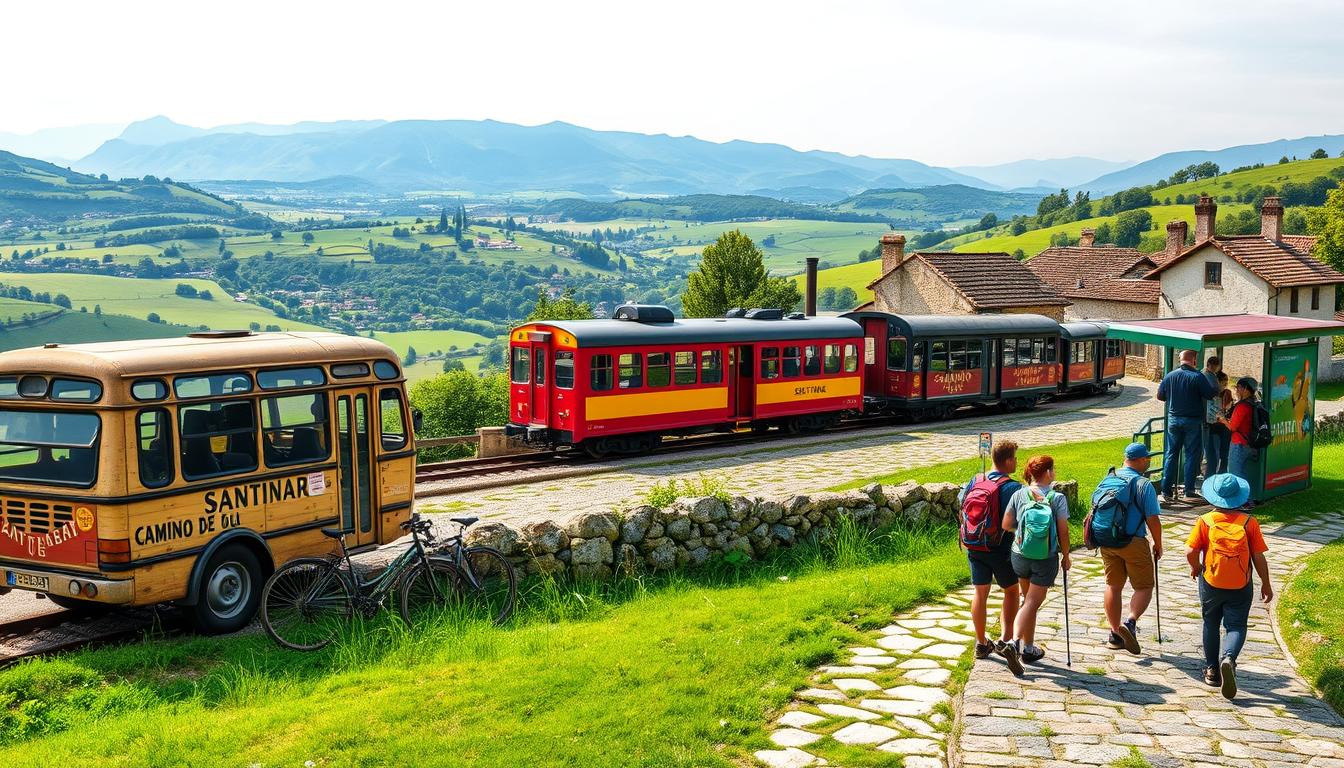The Camino de Santiago, also known as the Way of St. James, is a famous spiritual journey. It attracts adventurers from all over the world. When planning this trip, one of the first things you think about is the cost.
The expenses for the Camino de Santiago can change a lot. This depends on the route you pick, where you stay, and how you travel. Knowing these costs helps you plan a successful and meaningful journey.

Key Takeaways
- The Camino de Santiago offers a range of cost options to suit different budgets and travel styles.
- Factors like route selection, accommodation choices, and transportation can significantly impact the overall expenses.
- Advance planning and research can help you manage your Camino de Santiago costs effectively.
- Budgeting for essentials like travel insurance, gear, and daily expenses is crucial for a smooth and worry-free pilgrimage.
- Understanding the cost breakdown can help you make informed decisions and create a realistic budget for your Camino de Santiago adventure.
Understanding the Camino de Santiago Experience
The Camino de Santiago, also known as the Way of St. James, is a famous pilgrimage route. It attracts travelers from all over the world. This journey through Spain offers a unique experience for those seeking spiritual, cultural, or personal growth.
Knowing the details of this pilgrimage helps you plan better. It ensures you make the most of your Camino experience.
Different Camino Routes Available
The Camino de Santiago has several routes, each with its own charm and terrain. Some of the most popular routes include:
- Camino Francés: The most famous route, starting from the French Pyrenees and ending in Santiago de Compostela.
- Camino Portugués: A coastal path starting in Porto, Portugal, and passing through the Iberian Peninsula.
- Camino del Norte: A challenging route along Spain’s northern coast, offering beautiful ocean views.
- Camino Primitivo: The oldest route, believed to be the first path to Santiago de Compostela.
Best Time to Walk the Camino
The Camino de Santiago can be walked all year, but some seasons are better than others. Spring (April-June) and fall (September-November) are the most popular times. The weather is mild, and the landscapes are lush.
Summer (July-August) can be hot, while winter (December-February) is cooler with more rain.
Duration and Distance Considerations
The Camino’s length varies by route, but most cover 100-800 kilometers. The Camino Francés, the most popular route, takes 4-5 weeks to complete. Some experienced walkers finish it in 2-3 weeks.
| Camino Route | Approximate Distance | Typical Duration |
|---|---|---|
| Camino Francés | 780 km (485 miles) | 4-5 weeks |
| Camino Portugués | 610 km (380 miles) | 3-4 weeks |
| Camino del Norte | 825 km (515 miles) | 4-6 weeks |
| Camino Primitivo | 320 km (200 miles) | 2-3 weeks |
The Camino de Santiago offers a rich mix of experiences. From diverse landscapes to cultural and spiritual insights, it’s a journey like no other. By understanding the different routes, seasons, and duration, you can plan your Camino adventure. This ensures it meets your personal goals and budget.
How Much Does It Cost To Do Camino De Santiago: A Complete Breakdown
Planning a trip on the Camino de Santiago means thinking about costs. This guide will help you understand expenses and plan your budget.
The Camino expenses fall into several main areas:
- Pre-pilgrimage preparations
- Transportation to the starting point
- Accommodation during the walk
- Food and dining along the way
- Optional activities and additional expenses
Now, let’s look at the estimated costs for each area. This will help with pilgrimage cost analysis and budget planning.
Pre-Pilgrimage Expenses
Before starting, you’ll need travel insurance, a pilgrim’s passport, and gear. These costs can be from $50 to $300, based on your needs.
Transportation to the Camino Starting Point
Getting to the Camino’s start can cost a lot. It depends on where you’re from and how you travel. Prices can be from $50 to $500 or more, affecting your budget a lot.
Accommodation along the Camino
Accommodation is a big expense on the Camino. You can choose albergues or hotels. Prices are from $10 to $100 per night, based on comfort and amenities.
Food and Dining
Eating well on the Camino is key. You can eat at cafés, restaurants, or cook yourself. Daily food costs are from $15 to $50 per person.
Knowing these costs helps plan your Camino expenses breakdown and pilgrimage cost analysis. This way, you can have a great and affordable journey. The Camino is personal, so your budget will reflect your travel style.
Essential Pre-Pilgrimage Expenses
Starting the Camino de Santiago journey is more than just packing. You need to think about several key costs before you go. These include travel insurance, specialized gear, and more. These expenses help set up a memorable trip.
Travel Insurance Requirements
Travel insurance is a must for every pilgrim. It protects you from medical emergencies, trip cancellations, and other issues. It’s important to find the right insurance policy before you start.
Pilgrim Passport (Credencial) Costs
The pilgrim’s passport, or Credencial, is a key item for travelers. It lets you stay in albergues and collect stamps. Getting a Credencial usually costs a little bit of money.
Required Gear and Equipment
Every Camino journey needs the right pilgrim essentials. You’ll need comfy shoes, socks, backpacks, and rain gear. These pre-Camino costs can add up. But, investing in good gear is key for a comfortable trip.
“Preparation is the key to a successful Camino experience. Taking the time to research and budget for these essential pre-pilgrimage expenses will pay dividends down the road.”
Transportation Costs to Starting Points
Starting the Camino de Santiago means finding your way to the beginning. There are many ways to get there, each with its own cost. Knowing these costs helps you plan your Camino transportation and travel expenses better.
Many people start in Saint-Jean-Pied-de-Port, France. Getting there involves flights, trains, and buses. Prices can be from $150 to $300 or more, depending on where you start and when you go.
If you’re starting in Spain, trains or buses are good choices. Prices vary from $50 to $150 or more. This depends on how far you’re traveling and the service you choose.
It’s smart to look at different ways to travel. This helps you find the best option for your budget. Planning ahead makes your start on the Camino smooth.

The Camino de Santiago is a special journey. The cost to get there is just one part of it. By thinking about your travel needs and budget, you can enjoy the spiritual and personal growth the Camino offers.
Daily Accommodation Options and Prices
Starting your Camino de Santiago journey means thinking about where you’ll stay each night. You can choose from albergues (pilgrim hostels) to hotels along the way. Knowing the costs and benefits helps you plan your budget and enjoy your pilgrimage.
Albergue vs. Hotel Costs
Albergues are a favorite for pilgrims because they’re affordable. They cost between €5 and €15 per night. On the other hand, hotels can cost between €30 to €100 per night, depending on the location and amenities.
Private Room Considerations
Private rooms are available in some albergues and hotels. They cost between €20 to €80 per night. These rooms are great for couples, families, or those who want a quieter place to stay.
Booking in Advance vs. Walk-ins
The Camino gets busy, especially in peak seasons. Booking ahead can save you money and ensure a place to stay. But, some pilgrims prefer to book on the spot. This can lead to surprises but also means you might not find a place in popular areas.
“The Camino is not just a physical journey, but a spiritual one as well. The choice of where you rest your head can have a significant impact on your overall experience.”
Whether you prefer albergues or hotels, planning ahead and being flexible is key. This way, you can make the most of your Camino de Santiago journey and have a comfortable trip.
Food and Dining Expenses Along the Way
Food and dining are key parts of the Camino de Santiago pilgrimage. As you start your journey, you’ll find many Camino food costs, pilgrim meals, and dining options to keep you going.
Along the Camino, you can try different dining spots. You’ll find cozy cafes, local eateries, and supermarkets. These places offer great ways to refuel after your walks.
Pilgrim meals often include stews, fresh bread, and local dishes. Don’t miss Pulpo a la Gallega (Galician-style octopus), a must-try in Galicia. You can find these meals in albergues and restaurants made for travelers.
| Dining Option | Estimated Cost (EUR) |
|---|---|
| Supermarket Purchases | 5-10 per day |
| Pilgrim Menu (Menu del Peregrino) | 8-15 per meal |
| Local Restaurant Meal | 12-20 per meal |
It’s smart to balance enjoying local food and keeping your Camino food costs in check. Many choose the Pilgrim Menu for its good value. It usually includes bread, a main dish, and a drink.
By choosing wisely and budgeting, your food experiences on the Camino will enhance your journey. This is true for both your body and wallet.

Expected Daily Budget for Different Travel Styles
Planning your Camino de Santiago pilgrimage means thinking about your budget. Your travel style can greatly affect how much you spend each day. Whether you’re on a tight budget, looking for a mid-range option, or want luxury, knowing the costs helps you plan.
Budget Pilgrim Costs
For a budget-friendly Camino, expect to spend $30 to $50 daily. This includes staying in albergues and using low-cost accommodations. You can eat at bakeries, supermarkets, and pilgrim-friendly places, enjoying local food without breaking the bank.
Mid-Range Expenses
For a comfortable yet affordable trip, budget $50 to $100 daily. This allows for private rooms, local restaurants, and some extra activities. It’s a good balance between comfort and cost.
Luxury Pilgrimage Options
For a luxurious Camino, budget $100 to $300 or more daily. This means staying in paradores, boutique hotels, or villas. You’ll also enjoy gourmet meals and unique experiences.
| Travel Style | Approximate Daily Budget | Key Considerations |
|---|---|---|
| Budget Pilgrim | $30 – $50 | Albergues, basic meals, minimal extras |
| Mid-Range | $50 – $100 | Private rooms, local restaurants, some activities |
| Luxury Pilgrimage | $100 – $300+ | Paradores, gourmet dining, premium experiences |
Your Camino budget depends on your preferences and travel style. By considering these options, you can plan a journey that fits your comfort and budget.
Additional Costs and Optional Expenses
Starting your Camino de Santiago journey means thinking about extra costs and optional expenses. These can include souvenirs, laundry, and unexpected expenses. They might come up during your pilgrimage.
The Camino de Santiago offers a unique experience. Many pilgrims are drawn to the local culture and traditions. Buying souvenirs, like handcrafted items or traditional clothing, is a great way to remember your journey. But, remember to include these costs in your budget to avoid overspending.
You might need laundry services during your trek. Many albergues offer basic laundry facilities, but prices vary. Set aside a small part of your daily budget for laundry. This will help keep your clothes fresh and clean during your Camino adventure.
FAQ
What is the Camino de Santiago and why is understanding the costs important?
The Camino de Santiago is a famous pilgrimage route in Spain. It attracts thousands of travelers each year. Knowing the costs helps you plan and budget your trip well.
What are the different Camino routes available?
There are several Camino routes, each with its own charm and costs. The Camino Francés, Camino Portugués, and Camino del Norte are the most popular.
When is the best time to walk the Camino de Santiago?
The best time to walk the Camino depends on what you like and your budget. Spring (April-June) and fall (September-November) are the best seasons. They have nice weather and fewer people.
How do the duration and distance of the Camino affect the overall costs?
The length and distance of your Camino route affect your costs. Longer routes, like the Camino Francés, need more days of staying and eating. This means higher expenses.
What are the essential pre-pilgrimage expenses I should consider?
Before starting your Camino, think about travel insurance, a pilgrim’s passport (Credencial), and the gear you need.
How much does it cost to get to the starting points of the Camino?
Getting to the Camino’s start can cost a lot, depending on where you are and how you travel. Flights, trains, and buses all add to the cost.
What are the accommodation options and their associated costs along the Camino?
You can choose from albergues (hostels), hotels, and private rooms on the Camino. Prices vary based on the type, location, and if you book in advance or not.
How much can I expect to spend on food and dining during the Camino?
You can manage your food and dining costs on the Camino. You can eat at supermarkets, cafes, or restaurants. Daily costs can range from cheap to expensive.
What is the expected daily budget for different travel styles on the Camino?
Your daily budget on the Camino depends on your travel style. Budget travelers, those in the middle, and luxury seekers will have different costs.
What are some additional costs and optional expenses I should be aware of?
Besides main expenses, there are extra costs for souvenirs, laundry, and unexpected things. It’s wise to have a little extra money for these.
